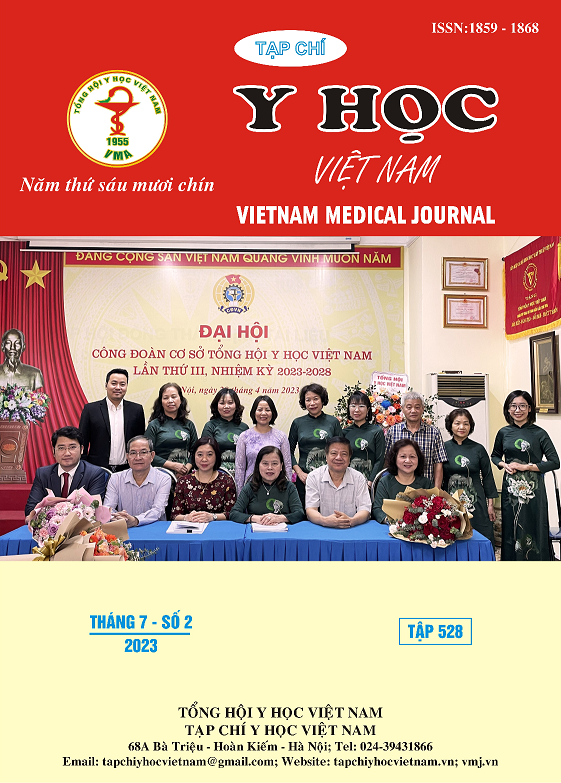REVIEW OF COLISTIN UTILISATION AT E HOSPITAL
Main Article Content
Abstract
Objectives: Investigate the Characterization of bacteria and the colistin resistance of Gram-negative bacteria isolated at E hospital. Study population and methods: A descriptive cross-sectional study was performed on 61 medical records of patients using colistin from January 2021 to December 2021 at E hospital. Results: The patients were mainly treated in the intensive care unit (83.6%) with the main infectious disease being pneumonia (78.7%). The samples taken were quite diverse, mainly sputum, blood and urine. The most common bacterial isolates associated with the indication for colistin were A. baumannii and P. aeruginosa, accounting for 57.1%% and 28.6%, respectively. Multi-resistant bacteria (MDR) accounted for the majority with the rate of 59.7%., A. baumannii was the most resistant strain (56.5%). There were 11 strains (8 strains of A. baumannii, 2 strains of P. aeruginosa and 1 strain of i that were completely resistant to antibiotics.Four strains of bacteria were analyzed with colistin A. baumannii, P. aeruginosa, K. pneumoniae and C. freundii has the ratio S, I, R respectively: 23.3%, 73.3%, 6.7%, of which, only 9 samples were returned with MIC results: A.baumannii had fluctuating MIC from: 0.025 to 0.5 µg/ml. Conclusion: Colistin is one of the last options for multi-resistant Gram-negative bacteria. In this study, strains of bacteria resistant to colistin appeared. Therefore, it is necessary to consider the choice of using colistin as well as optimizing the dose of colistin to prevent the emergence of resistant strains of bacteria.
Article Details
Keywords
colistin, resistance
References
2. El-Mahallawy HA, Swify ME, Hak AA, Zafer MM. Increasing trends of colistin resistance in patients at high-risk of carbapenem-resistant Enterobacteriaceae. Ann Med. 2022;54(1):1. doi:10.1080/07853890.2022.2129775
3. Pham Thanh D, Thanh Tuyen H, Nguyen Thi Nguyen T, et al. Inducible colistin resistance via a disrupted plasmid-borne mcr-1 gene in a 2008 Vietnamese Shigella sonnei isolate. J Antimicrob Chemother. 2016;71(8):2314-2317. doi: 10.1093/jac/dkw173
4. Magiorakos AP, Srinivasan A, Carey RB, et al. Multidrug-resistant, extensively drug-resistant and pandrug-resistant bacteria: an international expert proposal for interim standard definitions for acquired resistance. Clin Microbiol Infect Off Publ Eur Soc Clin Microbiol Infect Dis. 2012; 18(3):268-281. doi:10.1111/j.1469-0691.2011.03570.x
5. Phu VD, Wertheim HFL, Larsson M, et al. Burden of Hospital Acquired Infections and Antimicrobial Use in Vietnamese Adult Intensive Care Units. PloS One. 2016;11(1):e0147544. doi:10.1371/journal.pone.0147544
6. Wertheim H, Van Nguyen K, Hara GL, et al. Global survey of polymyxin use: A call for international guidelines. J Glob Antimicrob Resist. 2013;1(3):131-134. doi:10.1016/j.jgar.2013.03.012
7. Tuyền NB, Dung ĐTP, Quỳnh BTH, Hồng NT, Thông VD. phân tích việc sử dụng colistin tại bệnh viện đa khoa đồng nai. Tạp Chí Học Việt Nam. 2021;500(2). doi:10.51298/vmj.v500i2.373
8. Hải NT, Ngọc HM, Thuỷ NTT, et al. Thực trạng sử dụng kháng sinh colistin trên bệnh nhân lọc máu liên tục tại Bệnh viện Trung ương Quân đội 108. J 108 - Clin Med Phamarcy. Published online March 8, 2021. doi:10.52389/ydls.v16i2.726
9. Châu ĐTN. Khảo sát tình hình sử dụng kháng sinh colistin tại Bệnh viện Đại học Y Hà Nội. Khóa luận tốt nghiệp Dược sĩ. Trường Đại học Dược Hà Nội; 2018.
10. Kính NV. Phân tích thực trạng tháng 10 - 2010 Hợp tác toàn cầu về kháng sinh - GARP (Global Antibiotic Resistant Partner) - Việt Nam - (Phối hợp với đơn vị nghiên cứu lâm sàng ĐH Oxford). Published online 2010.


